You are reading the older HTML site
Positive Feedback ISSUE
13may/june 2004
Art goes to Home Entertainment 2004, Part 3
by Art Shapiro
In this report, I'll share some pictures of a few systems or components that struck my fancy as offering nice sound.
With only one exception I'll detail later, I took only two CDs to HE2004, and had an opportunity to audition one track of each CD on, literally, dozens of different systems. Those two CDs were a piano CD of the music of Liszt performed by Earl Wild. Entitled "Earl Wild Plays Liszt in Concert", on Ivory 73002, I played the 4th Hungarian Rhapsody, a tour de force that encompasses much of the capacity of the piano. The second CD was of the music of Argentine composer Maximo Diego Pujol, and I played the third movement of his Suite Buenos Aires, a violin and guitar piece I learned about from a wonderful recital at the 2002 show, also in New York. This was on ASV 73002.
One really pleasant surprise came in a room full of various headphones from the folks at AKG. A wireless unit was giving quite acceptable sonics, and I couldn't help but think how nice that unit might be in an office environment. The pièce de résistance, however, was their top-of-the-line K1000 system, which might be better termed "earspeakers" rather than "headphones". Rather than clamp loosely or tightly against the listener's ears, the transducers are actually somewhat angled at perhaps a 20° angle, with the front touching the listener and the rear completely separated.
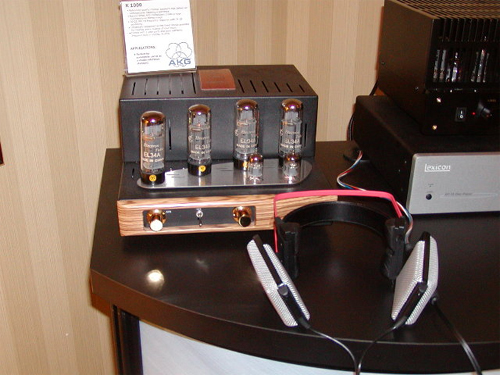
The picture shows a the little EL34 tubed amplifier that was providing excellent sound. Interestingly enough, despite the transducers being quite exposed to the environment, little sound was apparent as one got more than a few feet from the listener. Everyone who tried the K1000 was raving about the good sound. Here's a picture of reader Loren Frumker modeling the AKG unit; the angle of the earspeakers is quite apparent.

Another room that consistently impresses me is the Merlin system, with each year's version of the VSM (Very Scary Monitor) speakers. As has been consistent the last several shows, the VSMs were being powered by big Joule Electra monoblocks. Here's one of my few traditional straight-on photos of this fine system.

I've had the VSMs in my home for review, and have always liked the fact that these medium-sized speakers produce a surprisingly big and powerful sound—an asset in my book—and seem comfortable reproducing all forms of "serious" music that I've thrown their way. I have to share a contrarian viewpoint from reader Loren Frumker, who was walking around with me a couple of the several times I entered this room. Loren expressed the opinion that he has tried several times over the years to like the Merlins, and they just never have registered positively on him. He prefers speakers that offer a little more transparency. As Loren owns big Legacy Whispers, which are not conventional box speakers, I can understand and respect his sonic preferences. For myself, a "tonal accuracy" and "power" afficianado, this system is one I can sit back and enjoy for hours on end. I've actually toyed with the idea of ditching my big ESP Concert Grands for the VSMs, but I've gotten the ESPs sounding so good, after years of diddling, that now it probably won't happen. But I trust this shows how much I appreciate the Merlin sonics.
Another system that I spent a fair amount of time enjoying was the room featuring Joseph Audio speakers driven by Manley electronics, with Jeff Joseph and EveAnna Manley consistently on hand. The Joseph Audio room has won Best In Show the last couple of shows, which in all honesty has been due to firm but good-natured lobbying for votes and carefully chosen source material in a scripted demo which probably skew the results upwards a few places. Nevertheless, the sound of this room has been consistently excellent over the years. It is a slightly warm, very listenable presentation which has struck me as quite similar to the Vandersteen sort of sound. Here's a picture of the room below.
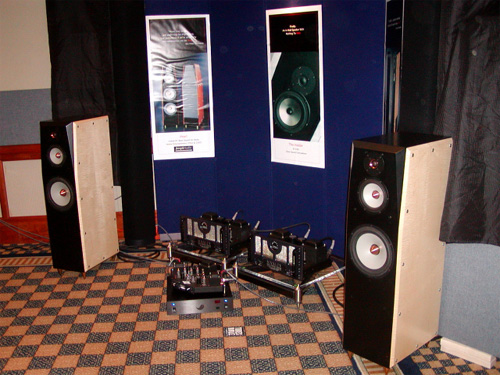
The new RM55LE speakers (about $12.5K) surround Manley Neo250 monoblocks that this writer uses in his own system, with a little Manley Stingray integrated amp in front. In the next shot you can see Jeff Joseph and the gorgeous La Luce turntable that has been used to good advantage the last several years; I believe Jeff uses a Cardas Purple Heart cartridge.

When it comes to showmanship, Jeff has few equals at these shows. He introduced the equipment, and started playing the scripted demo. It sounded quite nice, as one might expect. Then he let the audience in on a little secret: they weren't listening to the floorstanding RM55LE speakers and the big Manley monoblocks. What was actually being played was the little Manley Stingray and—the black curtains on the wall were drawn aside—new Joseph wall-mounted speakers, whose model number I somehow have missed.
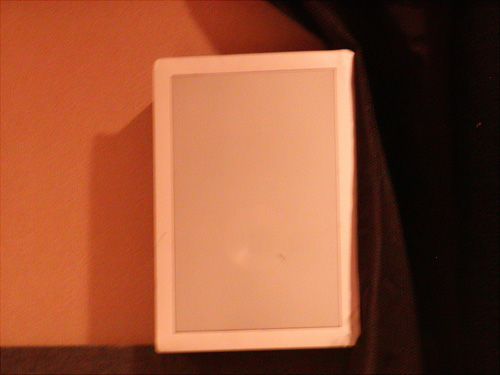
I believe these guys are in the $4K range, and given the sonic constraints of a wall-mounted speaker, what we were hearing was truly admirable. Then the room was, in fact, switched over to the big guys, and the enjoyable demo continued—quite short this year.
Jeff is famous for doling out M&Ms to the audience, and one day he came in sporting a fancy M&M necktie.
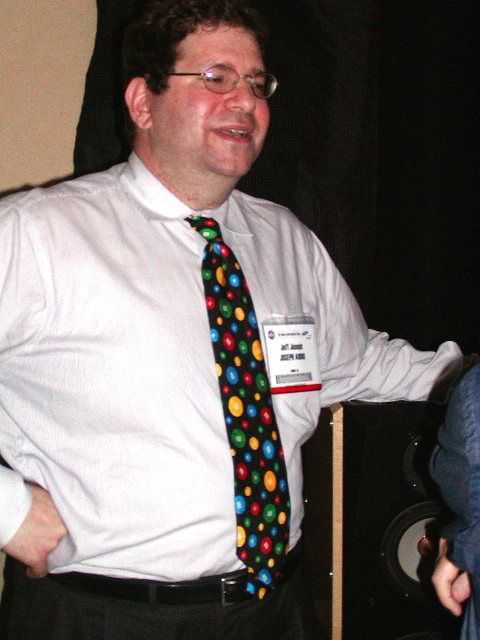
There were quite a few upper-strata turntables being used at HE2004; I've already cited a couple. One really impressive unit was the Brinkmann turntable, which I see has recently been reviewed here in Positive Feedback Online. Take a look at this guy below.
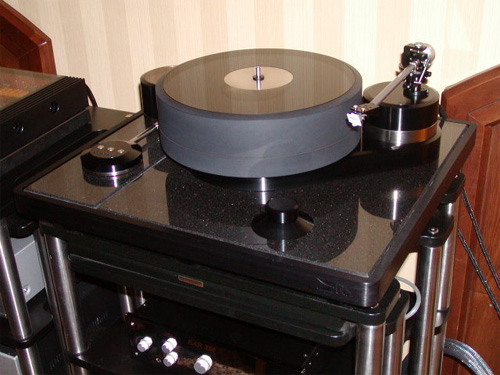
Just in back of the right front leg you will note a short loop of tubing. This is actually a tube carrying the bearing oil up the leg—the tube runs down the leg—from a heating unit on the bottom shelf of the rack. This optional component keeps the oil—a good pint's worth according to the representative—at a consistent 80° temperature, which is said to be optimal for the turntable's performance.
The Brinkmann unit was in Dan Meinwald's E.A.R. room, my picture of which somehow came out unusably blurry—sorry Dan! I sat a spell and was able to audition both my CDs. Playing the Suite Buenos Aires, this room system gave a nice "bite" to the slightly aggressive and strident violin on this recording, whereas the guitar reproduction impressed me with its appropriately reproduced melodic tonality.
A totally unfamiliar company was one of the unexpected finds of this show. The quite familiar monoblocks amps from Tenor Audio were driving line array speakers by a firm named Epiphany.
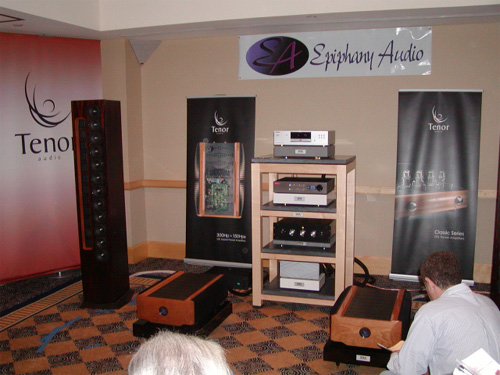
There are various models in the line with consistent naming scheme: this middle-of-the-line model was the 1212 and featured twelve midrange drivers and twelve tweeters, as we can see in the close-up below.
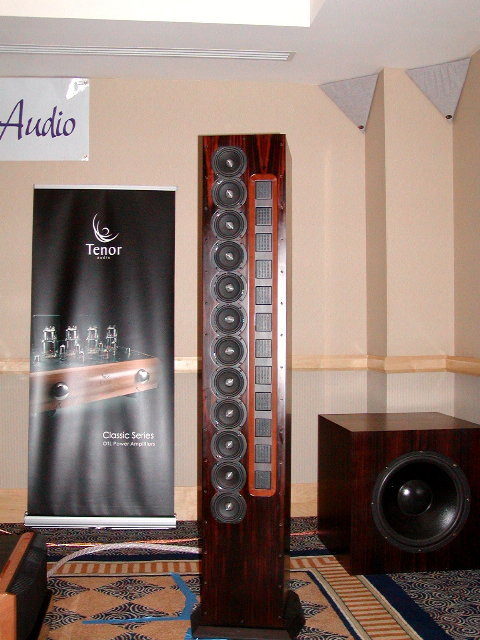
The big subwoofer can be observed in the rear corner. I was pleasantly surprised by the sound this system was giving, and was able to audition both my CDs. The clarity of piano runs and the effortless sense of power on the big Liszt piano chords was admirable. I spent several visits here over all four days, and was lucky enough to be there when some quite sophisticated music was brought in by show attendees, all of which was reproduced in a manner that consistently impressed me. This is the one system where I brought in a "ringer" beyond the previously cited two CDs. One day I brought in another Earl Wild CD, Earl Wild, the Romantic Master, that I've used in past years as my primary show auditioning vehicle. Choosing a gnarly finger twister, Mr. Wild's own Variations on (Handel's) The Harmonious Blacksmith, I was surprised to find a little bit of midrange congestion that hadn't manifested itself on the Hungarian Rhapsody. Whether that was a room limitation or a system characteristic couldn't be deduced in the time available. Nevertheless I remain quite impressed by the fact that this system, featuring a completely unfamiliar speaker, could do so well on such a diverse sampling of music. I hope to have the pleasure of encountering the company's wares in future shows.
I've taken quite a personal interest in CD transports of late, realizing that my own aging Wadia WT3200 won't last forever, and was quite attracted to a unit from the Chinese company Zanden.
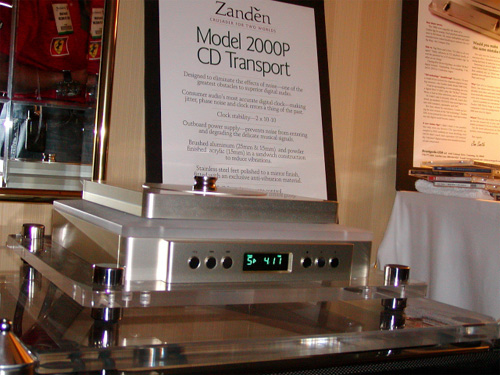
Alas for me, the pricing for this gorgeous transport is quite non-trivial: $18K to $25K depending on various clocking options. But that has to be one of the most attractive transports I've ever seen.
I'll conclude Part 3 by mentioning my first encounter with speakers that scuttlebutt has given a big "thumbs up": units from Bösendorfer, best known for making arguably the world's greatest concert grand pianos. I had heard that the speakers were exceptionally good at reproducing—surprise—the piano, and as that constitutes the vast bulk of my personal listening, my eyes lit up when I walked into the room.

These are the middle speaker in the product line, and they were being used with beautiful Art Audio electronics, casting a blue glow through the Plexiglas cylinders surrounding the power tubes.
Apparently the speakers mimic the behavior of a grand piano, in which sound is bounced off a sounding board; there is the equivalent functionality to the side of the speaker. This probably explains the healthy expanse of side grill. Between the amps you can observe a small VBT subwoofer, which wasn't being used.
On the other hand, in the Jaw Dropping Moment of HE2004, take a look at this photograph below.
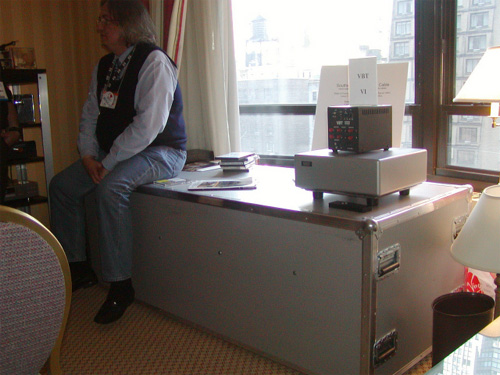
I figured that the huge steamer trunk was the case in which all the equipment had been transported to the show. Nope. That's another subwoofer! If we can measure the proverbial Wife Acceptance Factor (WAF) between 1 and 10, this probably registers about a minus seven!
Anyway, this system was terrific on piano, not to mention the guitar/violin CD. There are lots of systems that do well on most music, but can't cope with the demands of the concert grand piano. This was one of the systems that not only could cope, but utterly thrived on the piano repertoire. I spent several hours in that room, and had several long talks with the Bösendorfer representative, who actually invited me down to see the speakers being made in North Carolina. (I had figured they came from Germany.) Dynamics, tonality, excitement—these speakers could do it all. Perhaps an opportunity to hear the big guys in the product line will arise—I'd relish the experience.
With that wonderful Bösendorfer/Art Audio system, I'll conclude Part 3. Over and out.
